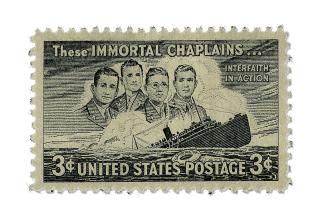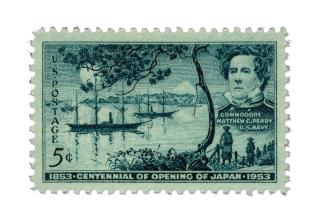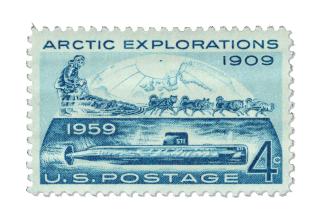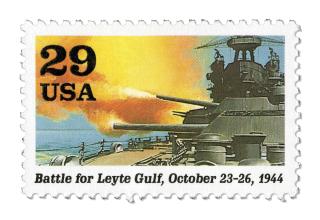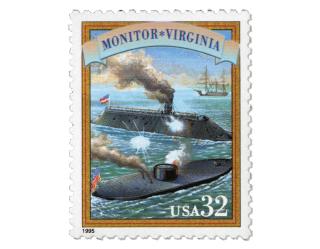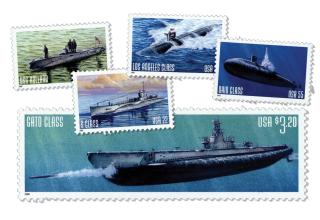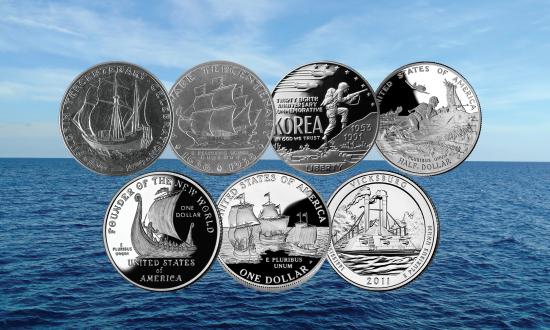For years after their first appearance in 1847, U.S. postage stamps showed only stern faces of assorted Founding Fathers. Non-portrait stamps, introduced in 1869, included the earliest appearance of a ship (although not a warship), the steamer SS Adriatic. The first Navy ship on a U.S. stamp was not for postage: Internal Revenue tax stamps issued in 1898 bore an engraving of the ill-fated USS Maine. (A century later, the Maine would make her appearance on a 1998 postage stamp commemorating the centennial of her sinking.)
President Franklin D. Roosevelt, an avid stamp collector, had served as Assistant Secretary of the Navy from 1913 to 1919. One of his pet presidential projects was a series of stamps, issued in 1936–37, honoring famous military leaders—including a fair share of naval greats. The 1-cent green depicted John Paul Jones and John Barry with the Revolutionary War ships Bonhomme Richard and Lexington. A 2-cent red bears portraits of Stephen Decatur and Thomas MacDonough Jr. with a fighting ship of the War of 1812; the frigate United States and corvette Saratoga are named. A 3-cent purple honors David Farragut and David Dixon Porter and shows a Civil War ship; the sloop-of-war Hartford and steam frigate Powhatan are named.
The 150th anniversary of “Old Ironsides,” the frigate Constitution, was commemorated in 1947 on a 3-cent stamp. The simple line drawing of the ship, by naval architect Andrew Hepburn, was criticized for “ignoring the ship’s grandeur.” The Constitution returned, in color this time, on a “forever” stamp for the 200th anniversary of the War of 1812. This one shows the earliest portrait of the ship, painted in 1803 by Italian-American maritime artist Michele Corné.
A dramatic sinking appears on a 1948 3-cent stamp honoring four Army chaplains who sacrificed themselves to save others when coastal transport SS Dorchester was torpedoed and sunk in the North Atlantic by German submarine U-223 in 1943. Operated by the War Shipping Administration, the Dorchester carried Navy Armed Guards manning her guns.
In 1853, Commodore Matthew Perry led a Navy squadron on a mission to negotiate a treaty opening Japan to American trade. A 1953 3-cent stamp commemorates this expedition, showing a moonlit view of ships in Tokyo Bay, with Mount Fuji in the background. The ships are probably the USS Mississippi (1841) and Susquehanna (1850), Perry’s flagship.
The 350th anniversary of the English settlement at Jamestown was marked with an International Naval Review in Hampton Roads, 8–17 June 1957. Warships from 17 nations joined some 80 U.S. ships in celebration. A 3-cent stamp issued for the event shows the aircraft carrier USS Saratoga (CV-60).
The 50th anniversary of Robert Peary’s 1909 polar expedition was commemorated on a 4-cent stamp, which also honored the voyage of the Navy’s (and world’s) first-ever operational nuclear submarine, the Nautilus (SSN-571). She reached the North Pole under the ice on 3 August 1958. This was the first Navy submarine on a stamp.
American Antarctic exploration is remembered on a series of stamps issued in 1988. The sloop-of-war Vincennes (1826), commanded by Lieutenant Charles Wilkes, was flagship of the 1838–42 United States Exploring Expedition. A 25-cent stamp depicts the Vincennes, a portrait of Wilkes, and a map of the ship’s track.
The epochal 1944 Battle of Leyte Gulf was commemorated in 1994 on a 29-cent stamp depicting a battleship firing a broadside during the action in Surigao Strait—history’s last fight between battleships. The unidentified ship could be the USS Maryland (BB-46), California (BB-44), Tennessee (BB-43), or Mississippi (BB-41).
A 1995 sheet of 20 32-cent stamps depicting Civil War scenes and personalities included the battle between the USS Monitor and CSS Virginia. Another Navy warship, probably the frigate USS Minnesota (1855), appears in the distance.
A miniature sheet of five stamps celebrated the 100th anniversary of U.S. Navy submarines in 2000. The USS Holland (SS-1) appears on a 60-cent stamp. An S-class submarine, one of 51 built between 1918 and 1925, is on the 22-cent. A long, narrow $3.20 stamp shows a submerged Gato-class submarine, one of 77 built between 1940 and 1944, firing a torpedo. On the 33-cent, a Los Angeles–class nuclear-powered submarine, one of 62 built between 1972 and 1996, cruises on the surface. Finally, a 55-cent stamp shows a submerged Ohio-class nuclear ballistic missile submarine, one of 18 built between 1976 and 1997.
A 2004 37-cent stamp honors the Navy’s last sail-only warship, the sloop-of-war Constellation, launched in 1854. A 2019 “forever” stamp commemorates the 75th anniversary of the commissioning of the Iowa-class battleship Missouri (BB-63). The stamp (not pictured) depicts a bow view of the iconic battleship in wartime configuration.
For more than a century, American stamps have honored naval history in a colorful manner. Most of these stamps retail today for less than a dollar. A collector could assemble a complete set at a very modest cost.
—Michael Markowitz, research specialist, Center for Naval Analyses; contributing writer, CoinWeek.com







